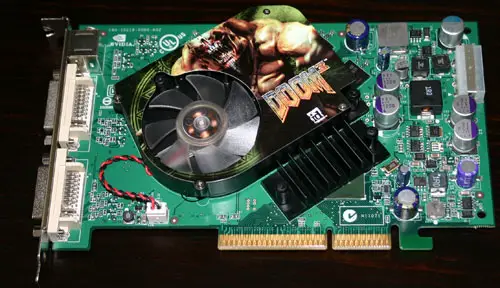Review NVIDIA GeForce 6600 vs 6600 GT Gaming: Overclocking | MHz | Benchmark – In this review, we continue testing the new product from NVIDIA, GeForce 6600. The first part of testing was devoted to reviewing the technical characteristics, capabilities and features of the new product, describing a reference card based on the new graphics processor, and, finally, examining its performance in synthetic tests.
Those who did not have time to read the first part of our review can do it here . Briefly summarizing the results of the first part of our testing, we can say that the new graphics processor from NVIDIA showed excellent results in synthetic tests, leaving no chance for the middle-class solutions of the previous generation and, at times, competing on equal terms with the previous generation video cards, previously belonging to the highest class.
In the second part of testing, we will evaluate the performance of new NVIDIA products in a number of modern gaming applications. Since the main area of application for consumer-grade graphics adapters is in games, it is testing in popular games, and not in synthetic applications, that will allow you to form a more adequate opinion about the new product. In order to be able to more fully assess the overall picture of performance, the number of games should be large enough and the genre composition should be varied. For the same purpose, it is necessary to use as modern games as possible, since they are the ones that use all the capabilities of modern graphics processors.
We tried to fulfill all of the above conditions by including games of different genres in the set of tests, as well as several new popular games, among which id Software’s creation, Doom 3, stands apart, to which we even devoted a separate article at one time (link to the article on Doom3) … In addition to this first-person shooter, we used a new version of the popular online shooter Countrer-Strike – Counter-Strike: Source, as well as a new synthetic benchmark based on the Half-Life 2 engine, which mainly demonstrates various effects achieved when using pixel shaders …
Test system and test conditions
First of all, we decided to compare the GeForce 6600 GT with the favorites of the last season, the GeForce FX 5950 Ultra and the RADEON 9800 XT, since both they and the new product from NVIDIA each have eight texture units, operate at comparable clock frequencies, and, what is even more importantly, they cost today from $ 200 to $ 300, and therefore, at the price they belong to the same class. Therefore, despite belonging to different platforms, these video cards are likely to be considered by potential buyers in the same row.
With the release of new solutions in the form of RADEON X800 XT / PRO and GeForce 6800 / Ultra / GT, old video cards that were once performance champions lost their positions, moving down a class, to the sector of mainstream video adapters. Unfortunately, this process is not proceeding too quickly, and the prices for such cards are still relatively high due to the low prevalence of new generation solutions on the market, however, over time, they will undoubtedly decrease, which will increase the attractiveness of such cards in the eyes of buyers. However, in this case they will have to compete with the new generation of graphics processors, which is no longer of the highest, but of the middle class – GeForce 6600 and RADEON X700. GeForce FX 5950 Ultra and RADEON 9800 XT have an indisputable advantage – 256-bit memory bus, and this can undoubtedly give them an advantage over the new product.
Besides the aforementioned cards, video cards based on GeForce 6800 GT and RADEON X600 XT with PCI Express interface took part in the tests. The latter, in fact, acted as a competitor to the GeForce 6600, which operates at lower frequencies compared to the GeForce 6600 GT, the older model in the new series of chips. We had to test video cards based on NVIDIA GeForce FX 5950 Ultra and RADEON 9800 XT on the AMD64 platform, since we did not have a motherboard equipped with AGP and PCI Express slots at the same time. Therefore, the results of video cards tested on different platforms can be compared, unfortunately, only indirectly. Our test platforms were configured as follows: Intel Prescott platform:
Intel Pentium 4 560 (Socket 775, 3.60GHz, 1MB L2 cache);
Intel Desktop Board D925CXC;
1GB DDR2 PC2-4300 (533MHz) SDRAM (Micron Technology, 2x512MB);
Samsung SpinPoint SP0812C (Serial ATA-150, 8MB buffer);
Creative SoundBlaster Audigy 2;
Microsoft Windows XP Pro SP2, DirectX 9.0с;
ATI CATALYST 4.8, NVIDIA ForceWare 65.76.
AMD Athlon 64 platform:
Athlon 64 3400+ CPU (2.20GHz, 1MB L2 cache);
ASUS K8V Deluxe mainboard;
OCZ PC-3200 Platinum EB DDR SDRAM (2x512MB, CL2.5-3-2-8);
Seagate 7200.7 HDD (SerialATA-150, 8MB buffer);
Creative SoundBlaster Audigy 2;
Microsoft Windows XP Pro SP2, DirectX 9.0с;
ATI CATALYST 4.8, NVIDIA ForceWare 61.77 (60.85 для 3DMark03).
The following games and applications were used in the testing process: First-person shooters:
Call of Duty;
Doom 3;
Unreal Tournament 2004;
Halo: Combat Evolved;
FarCry;
Painkiller;
Counter Strike: Source Beta
Third Person Games:
Splinter Cell: Pandora Tomorrow;
Prince of Persia: Sands of Time;
Hitman: Contracts;
Tomb Raider: Angel Of Darkness;
Thief: Deadly Shadows;
Max Payne 2: The Fall of Max Payne.
Simulators:
IL-2 Sturmovik: Aces;
Lock On;
Colin McRae Rally 04;
Strategy games:
Command & Conquer Generals: Zero Hour;
Perimeter.
Results for graphics cards tested on the AMD platform are marked with an asterisk in the diagrams.
Whenever possible, we have shown in the diagrams the value of the minimum frame rate, which, generally speaking, is no less important for determining the level of gameplay comfort than the value of the average speed.
As always, in games we chose the maximum graphics quality settings, and the settings were the same for all cards that took part in the testing process. For ForceWare 61.77, anisotropic and trilinear filtering optimizations have been enabled.
We should tell you more about the new driver from NVIDIA, ForceWare 65.76, which supports the GeForce 6600 family. In this driver, the Anisotropic optimization option has been renamed to
Anisotropic mip filter optimization and Anisotropic sample optimization option has been added . The first option changed only its name, while its essence remained the same as in previous versions of ForceWare – when this option is enabled, at all texture stages, except for the first, trilinear filtering is replaced by bilinear, which usually leads to a not very noticeable drop in quality images, but allows for a slight increase in performance. A new option called Anisotropic sample optimization, when enabled, performs a number of optimizations for texture samples, probably reducing the number of texture samples when it can be done without noticeably compromising quality. In this case, the first texture stage, again, is not affected.
It’s nice to see that full control over all possible optimizations is at the disposal of the user – NVIDIA has made a reasonable step that positively affects the confidence in its products.
Optimizations and image quality
Since the ATI CATALYST drivers are always enabled, and disabling them is accompanied by rather complex manipulations in the system registry, we left the optimizations enabled both in Catalyst and ForceWare in order to make comparative testing as adequate as possible.
According to NVIDIA’s recommendations, the greatest similarity between its products and those of its main competitor in the field of texture filtering optimizations is achieved when Trilinear optimization and Anisotropic sample optimization are turned on , while Anisotropic mip filter optimization should be turned off.
We did so, but before starting testing, we nevertheless took a few screenshots to try to establish how much the image quality might suffer when various types of optimizations were enabled. FarCry, Doom 3, Painkiller, Max Payne 2 and Counter-Strike: Source Beta were selected to test the image quality.
So, on the left – screenshots taken on an NVIDIA GeForce 6600 GT with optimizations turned off, in the middle – with Trilinear optimization and Anisotropic sample optimization turned on, and on the right – with all texture filtering optimizations turned on:
Well, according to static screenshots, the difference in image quality when Trilinear is enabled optimization and Anisotropic sample optimizationor it is difficult to notice all three types of optimization at once. However, in some situations, the quality degradation when you enable optimizations will be noticeable. The most revealing among these screenshots turned out to be images obtained in Max Payne: when the first two optimizations were turned on, the textures became clearer, but more “noisy”, and when the Anisotropic mip filter was activated , noticeable lines for switching MIP levels appeared.
Game tests: Call of Duty
Finally, let’s move on to the tests – it’s time to find out what performance the new product from NVIDIA will show in real gaming applications. Traditionally, testing is opened by three-dimensional first-person shooters, as the most popular and frequently encountered category of games.
In the very first test, the novelty showed an excellent result, ahead of all rivals. Traditionally, a high-quality driver and a high clock speed of the graphics processor allowed the GeForce 6600 GT to confidently outperform all rivals available today. The GeForce 6600 looks a little less impressive, but this does not prevent the weaker model from showing results on the level of a slightly more expensive ATI motherboard – RADEON X600 XT.
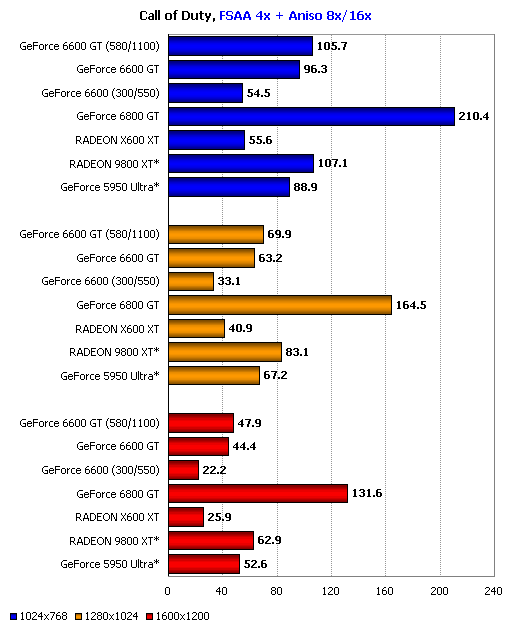
When you enable anti-aliasing, coupled with anisotropic filtering, the new items look not so good anymore. In this mode, the load on the memory subsystem increases significantly, and as a result, insufficient memory bus bandwidth affects the speed of the GeForce 6600 GT. Nevertheless, the new product managed to show decent results in resolutions up to 1280×1024, which is very, very good for a video card of this class. So, the new product has outperformed not only the RADEON 9800 XT, but also the GeForce FX 5950 Ultra, but taking into account its market positioning and huge potential for price reduction, we must admit that its performance in Call of Duty is at a decent level.
Game tests: Doom 3
The game allows you to record demos and play them in timedemo mode. Let’s see what results the GeForce 6600 GT will demonstrate in the “great and terrible”.
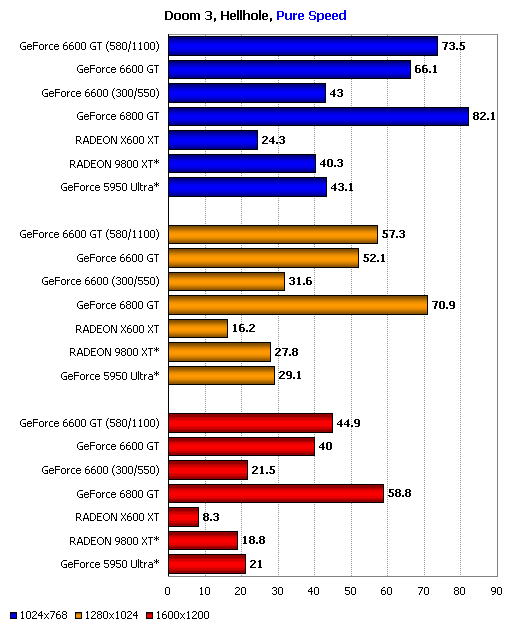
In Doom III, the hero of our review performed simply excellently, demonstrating unsurpassed results for middle-end video adapters: the GeForce 6600 GT outperforms the RADEON 9800 XT and only slightly lags behind the GeForce 6800 GT. This is not surprising: id Software’s graphics engine makes full use of the potential of NVIDIA graphics cards – UltraShadow technology.
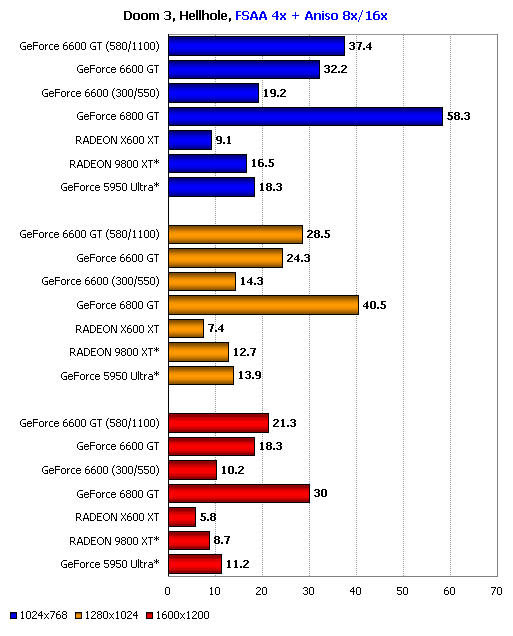
In the Eye Candy mode, only one thing has changed – thanks to the 256-bit memory subsystem, the gap between the GeForce 6600 GT and the 6800 GT has widened.
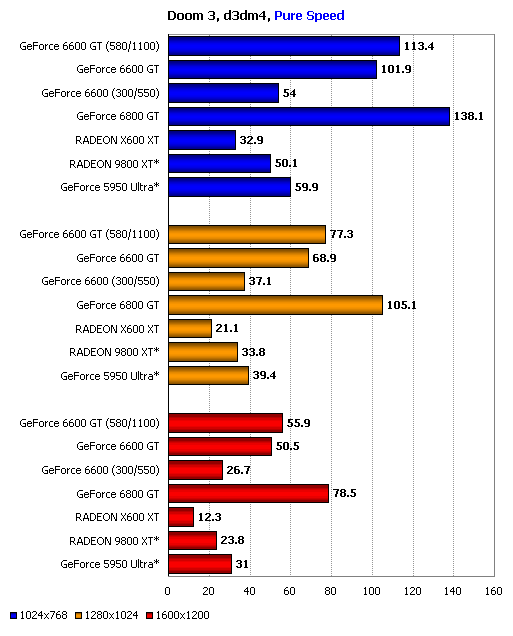
All of the above is also true for the d3dm4 level, except that the frame rate values are higher here, since there are no monsters at this deathmatch level.
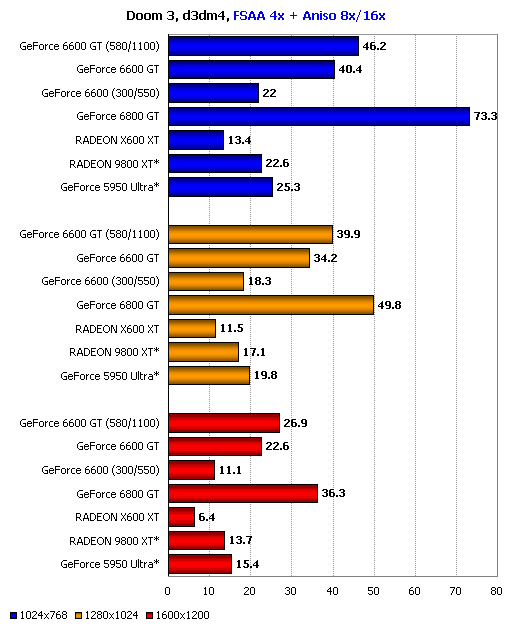
And again the GeForce 6600 GT is inferior only to the senior representatives of the new chip family from NVIDIA.
Game tests: Unreal Tournament 2004
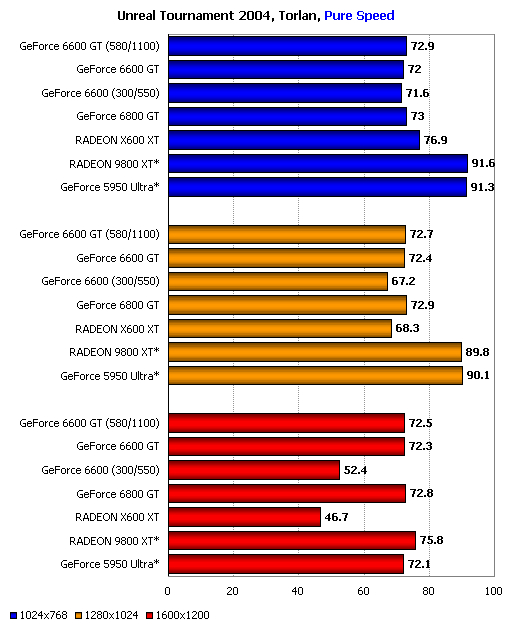
In the case of Unreal Tournament 2004, it is rather difficult to compare the GeForce 6600 GT with the solutions of the previous generation – the game engine clearly prefers the AMD platform. In this test, all the cards reached the ceiling determined by the speed of the system’s central processor, and this level on the AMD Athlon 64 3400+ turned out to be slightly higher than in the case of the Intel Pentium 4 “Prescott” at 3.6 GHz.
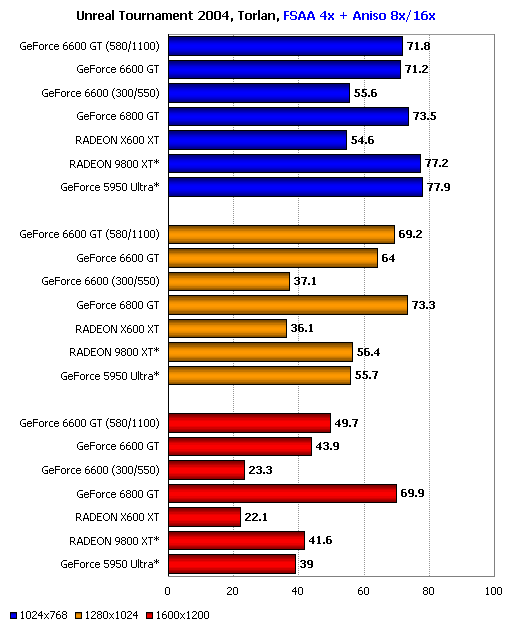
With full-screen anti-aliasing and anisotropic filtering enabled simultaneously, the processor speed limits the results only at 1024×768, in other resolutions the picture has become clearer – the GeForce 6600 GT is somewhat superior to the old generation cards, despite the presence of a narrow 128-bit memory bus.
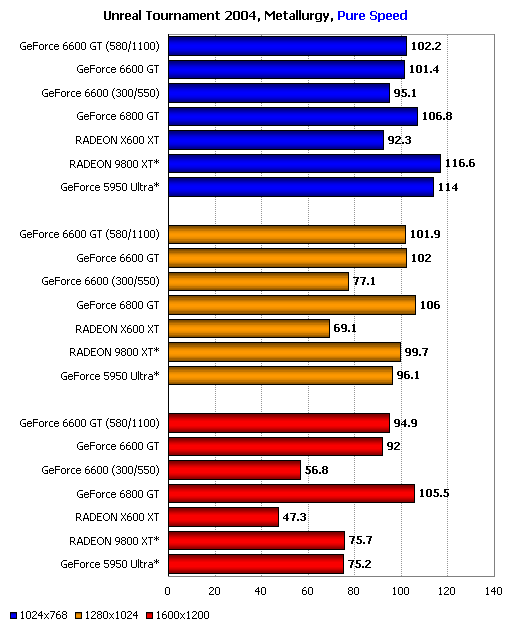
At the Metallurgy level, the picture is different: this level is simpler, and the performance ceiling, determined by the speed of the central processor, turned out to be higher. The GeForce 6600 GT demonstrates good results again, starting with a resolution of 1280×1024.
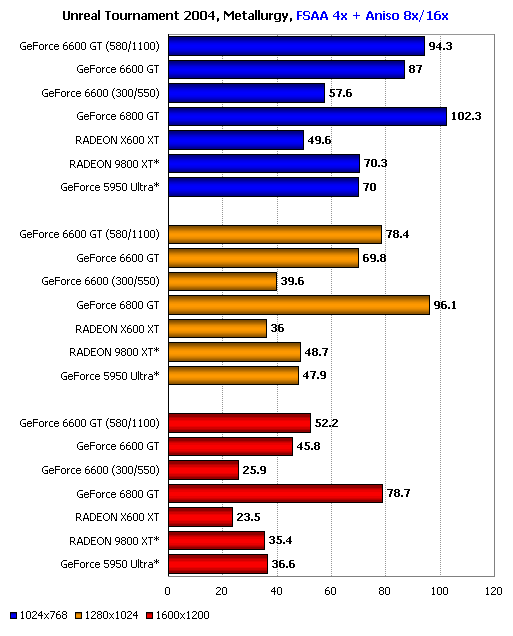
The novelty also feels good in high-quality mode: despite the presence of a 128-bit memory bus, the GeForce 6600 GT is ahead of all its rivals.
Game Tests: Halo: Combat Evolved
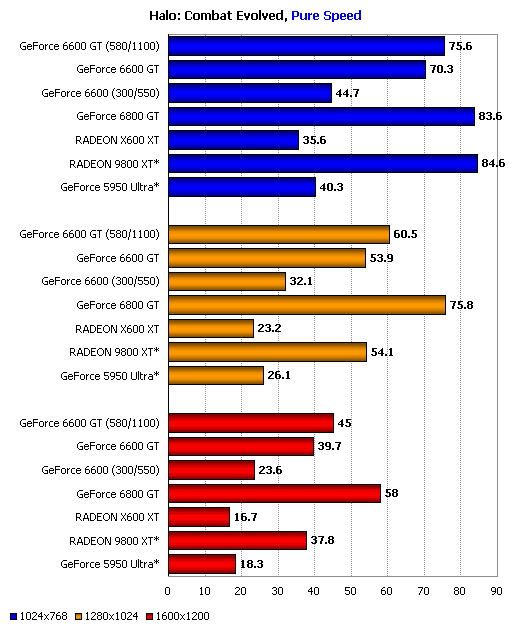
In Halo, the GeForce 6600 GT shows itself very worthy: with a lower memory bandwidth, but a higher fill rate, the GeForce 6600 GT outperforms ATI RADEON 9800 XT and NVIDIA GeForce FX 5950 Ultra as the resolution increases.
Game tests: FarCry
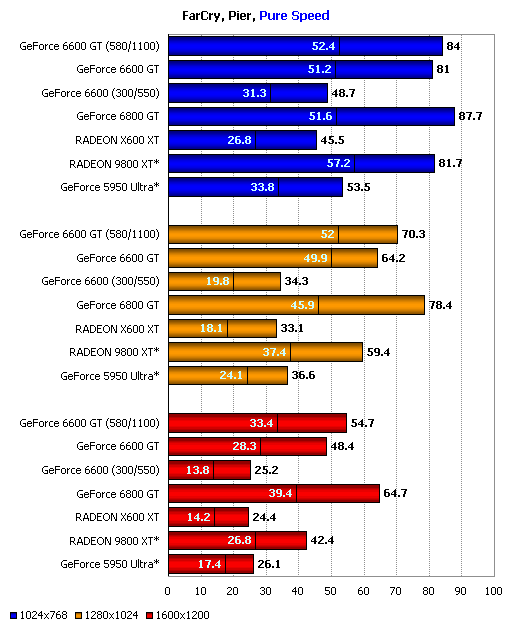
The performance of the GeForce 6600 GT is comparable to that of the RADEON 9800 XT – an excellent result for a video card equipped with a 128-bit memory bus.
It should be clarified that in Far Cry we choose the most efficient rendering path for each GPU, so we use Shader Model 3.0 path for all video cards based on NVIDIA GeForce 6 series GPUs, and this gives them a small speed boost.
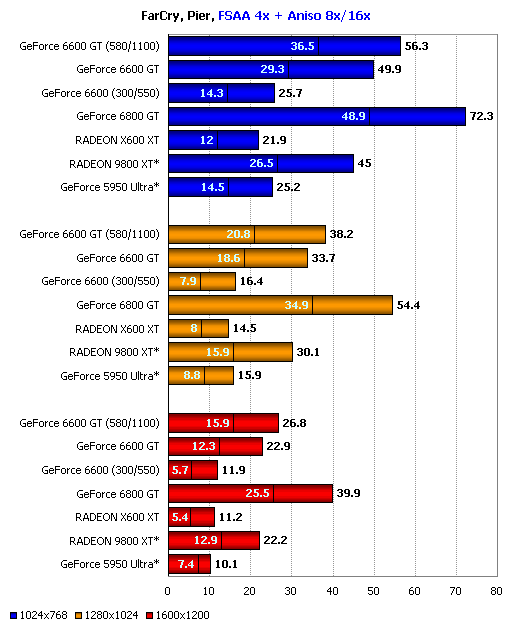
With full-screen anti-aliasing and anisotropic filtering enabled, the GeForce 6600 GT slightly outperforms the RADEON 9800 XT – an excellent result considering the lower memory bandwidth of the GeForce 6600 GT.
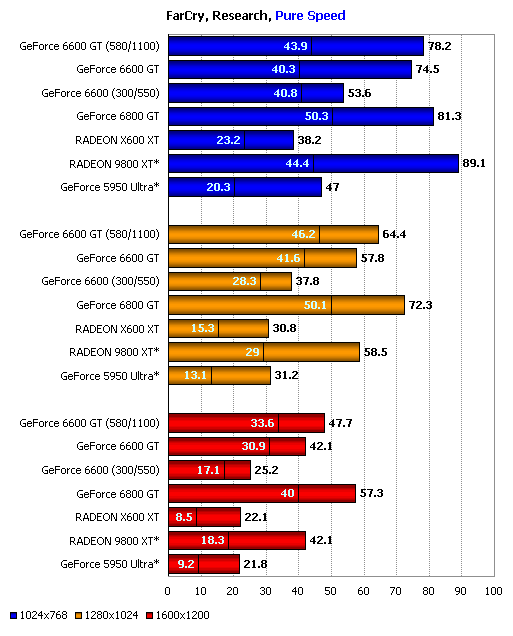
Here the GeForce 6600 GT is inferior to the RADEON 9800 XT only in the 1024×768 mode, being compared with the competitor when the resolution is increased. GeForce FX 5950 Ultra is hopelessly behind the GeForce 6600 GT.
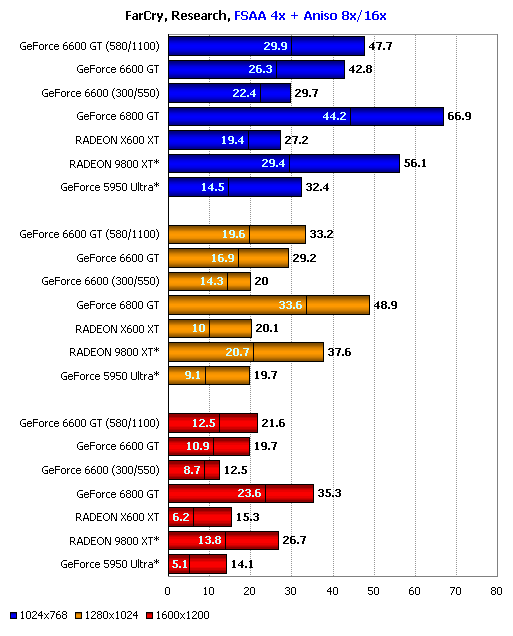
Here the GeForce 6600 GT, alas, is inferior to the RADEON 9800 XT – the high efficiency of shader execution and the presence of a 256-bit memory bus make the RADEON 9800 XT superior to the new product from NVIDIA.
Game Tests: Painkiller
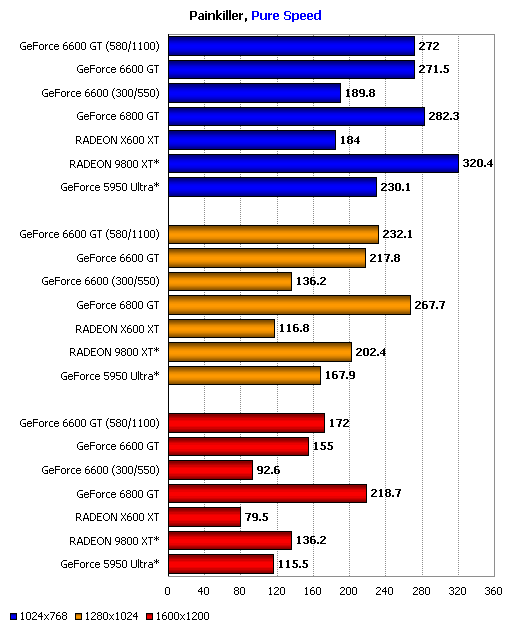
In Painkiller, as in Unreal Tournament 2004, the performance ceiling set by the CPU speed is higher on the AMD platform.
Therefore, we can seriously consider only the results obtained at a resolution of 1280×1024 and higher. In these modes the GeForce 6600 GT is slightly ahead of the ATI RADEON 9800 XT. The GeForce 6600 is only able to outperform the RADEON 9600 XT, but the performance level demonstrated by the board turns out to be quite sufficient for a comfortable game.
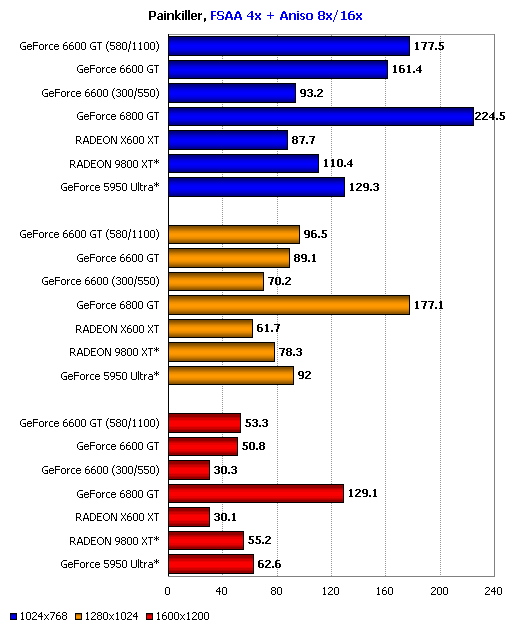
In 1024×768 mode the GeForce 6600 GT shows good results, but as the resolution increases, the requirements for the memory bus bandwidth increase. At 1280×1024, the card based on the GeForce 6600 GT with a 128-bit memory bus is inferior to the GeForce FX 5950, and at 1600×1200 it is inferior to the RADEON 9800 XT. However, even being limited by the size of the memory bus bandwidth, the GeForce 6600 GT-based card demonstrates quite playable speed.
Game tests: Counter-Strike: Source Bet
Counter-Strike is the world’s most popular online shooter. Until recently, this game used the rather outdated Half-Life engine, which does not use the capabilities provided by modern video adapters. However, not so long ago Valve released a beta version of Counter-Strike: Source, which is based on the next generation graphics engine – Source.
Like Doom III, Counter-Strike: Source Beta is capable of recording and replaying demos, and also has a timedemo mode, which makes the game easy to use as a test tool. Here’s what data was obtained with its help:
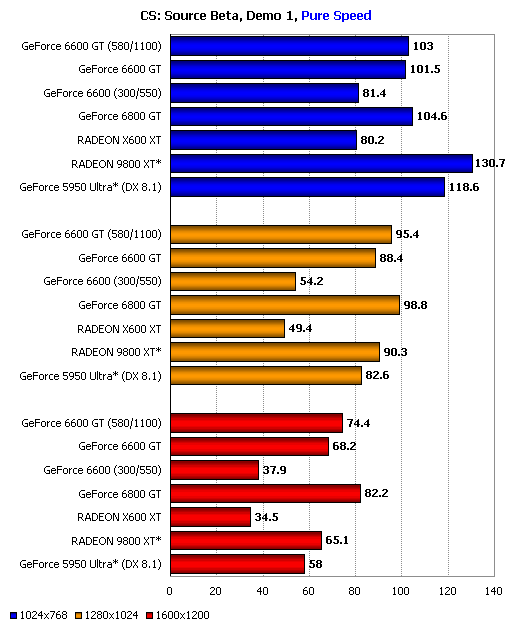
Several other demo recordings were used to test cards with PCI Express interface, because during testing the game engine managed to be updated using the Valve Steam system, and the old versions of the recordings stopped playing. The results obtained can be considered adequate only starting from the resolution of 1280×1024, since in the mode of 1024×768 the results of the fastest video cards seemed to be limited by the speed of the central processor.
Here the GeForce 6600 GT shows good results, roughly comparing with the RADEON 9800 XT in speed. The cheaper version, the GeForce 6600, is consistently outperforming the RADEON X600 XT.
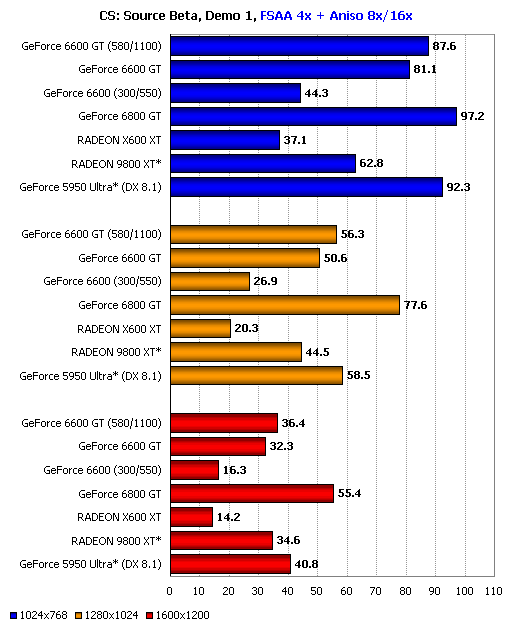
In the mode with full-screen anti-aliasing and anisotropic filtering enabled, the GeForce 6600 GT outperforms the RADEON 9800 XT in all modes, except 1600×1200, where the increased requirements for the memory bus bandwidth force it to yield to its competitor with a 256-bit video memory bus. NVIDIA GeForce FX 5950 Ultra shows unexpectedly high results, however, do not forget that this video card works here in DirectX 8.1 mode, which means that the results obtained on the GeForce FX 5950 Ultra cannot be compared with the results of other video cards.
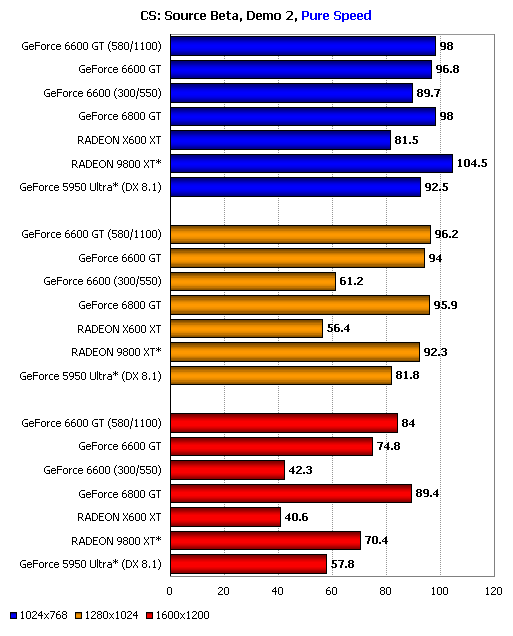
In the second test entry, the GeForce 6600 GT again demonstrates the results on the level of the RADEON 9800 XT.
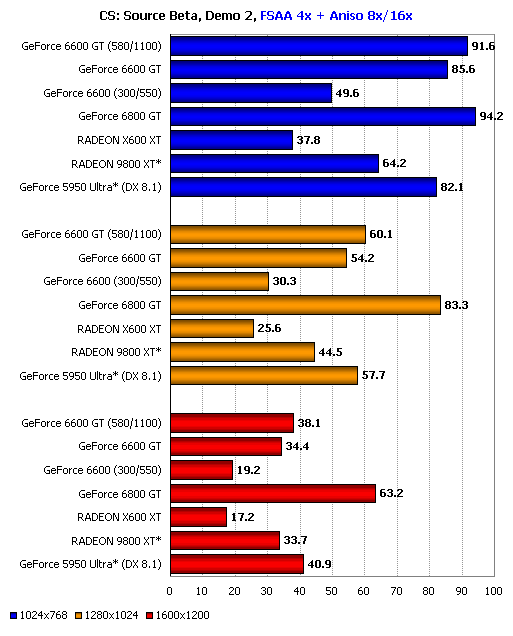
With full-screen anti-aliasing and anisotropic filtering enabled, the NVIDIA GeForce 6600 significantly outperforms the ATI RADEON 9800 XT, but as the resolution increases, the advantage of the new product fades away – its speed is limited by the lower performance of the memory subsystem.
Game tests: Splinter Cell: Pandora Tomorrow
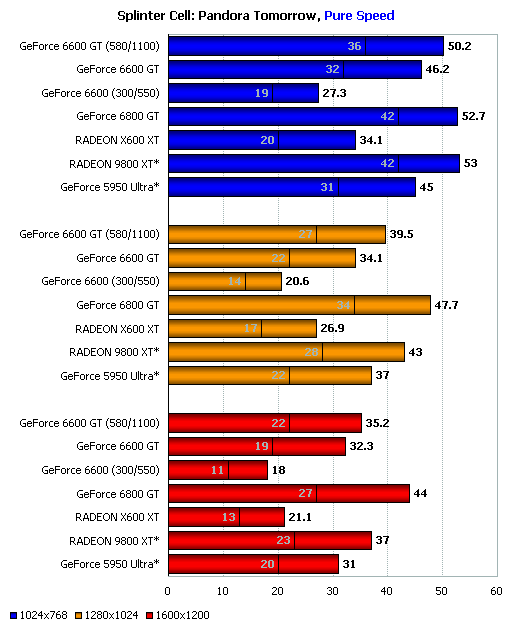
NVIDIA GeForce 6600 GT shows decent results in Splinter Cell: Pandora Tomorrow, only slightly inferior to the RADEON 9800 XT due to the lower memory bandwidth.
Game tests: Prince of Persia: Sands of Time
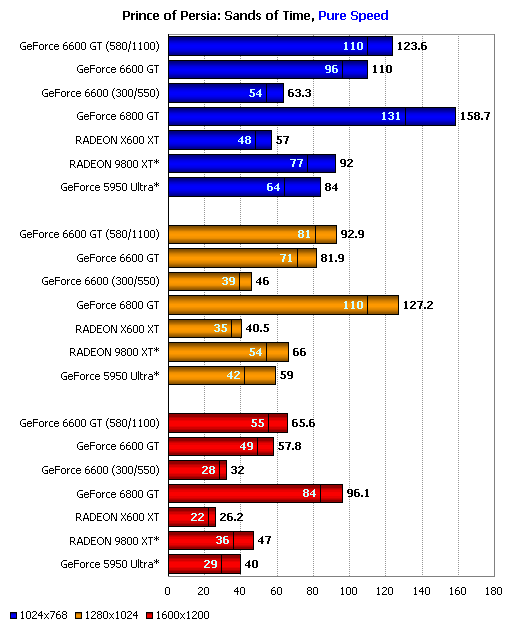
There is nothing to comment on – the test results show the complete superiority of the architecture of the new generation chips over the old graphics processors. However, the gap between the RADEON 9800 XT and the GeForce 6600 GT is not too big.
Game tests: Hitman: Contracts
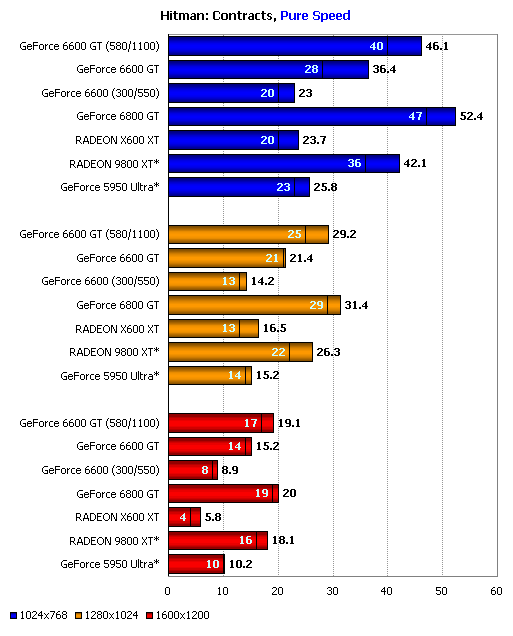
Here the new product performs worse than in the previous test. NVIDIA GeForce 6600 GT lags behind ATI RADEON 9800 XT, but outperforms NVIDIA GeForce 5950 Ultra. In general, the results of all tested video cards in this test are very low – even the GeForce 6800 GT cannot overcome the 60 frames per second bar.
Game tests: Tomb Raider: Angel of Darkness
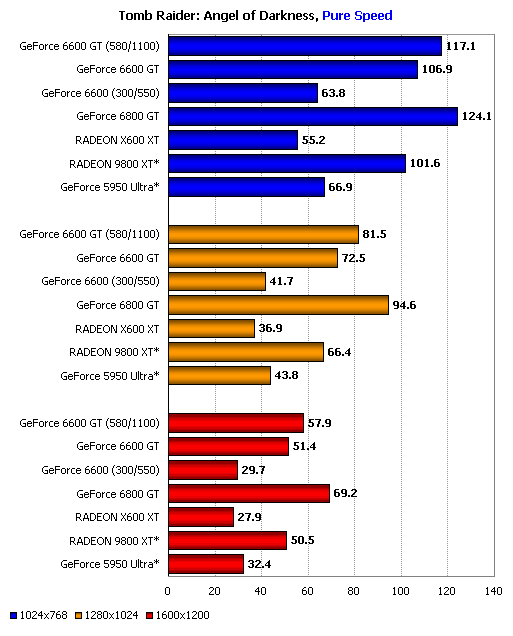
Tomb Raider: Angel of Darkness, a game that once seemed like a disaster for the GeForce FX, demonstrates the superiority of the new architecture and high clock speeds in a remarkable way – the GeForce 6600 GT easily outperforms the RADEON 9800 XT, not to mention the GeForce 5950 Ultra.
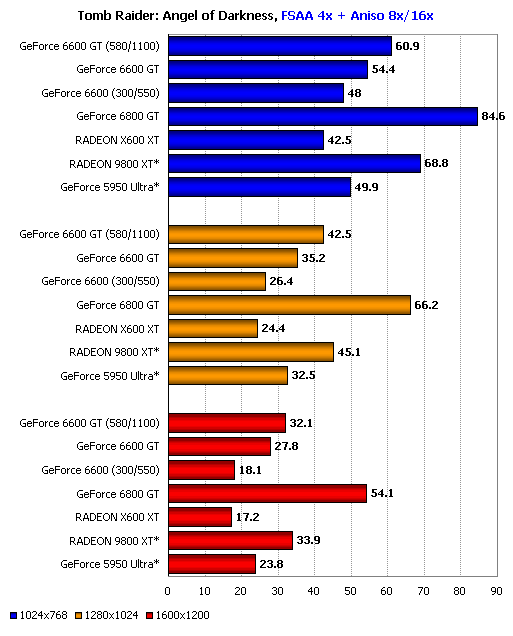
With anisotropic filtering and full-screen anti-aliasing enabled, NVIDIA GeForce 6600 GT, which is not surprising, lags behind RADEON 9800 XT – the latter has a faster memory subsystem.
Game tests: Thief: Deadly Shadows
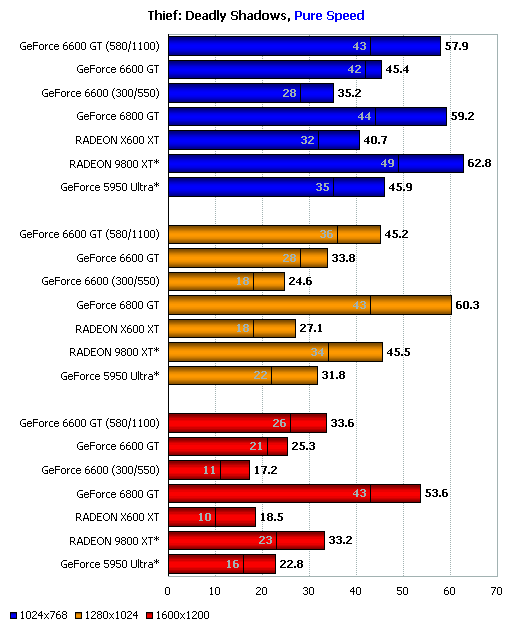
Here, in the 1024×768 mode, the results of the fastest video cards were limited by the speed of the central processor, but with increasing resolution this limitation becomes insignificant – the results are determined by the speed of the video cards. NVIDIA GeForce 6600 GT noticeably lags behind ATI RADEON 9800 XT, but when overclocked it reaches its performance level.
Game tests: Max Payne 2: The Fall of Max Payne
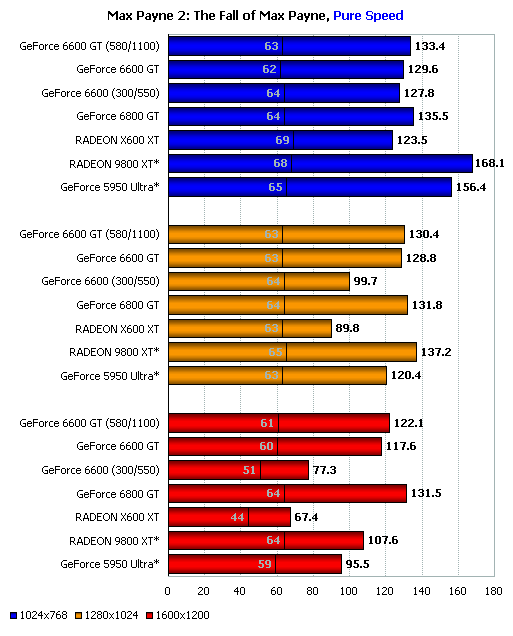
It is difficult to draw conclusions here – the results of almost all video cards are seriously limited by the speed of the central processor.
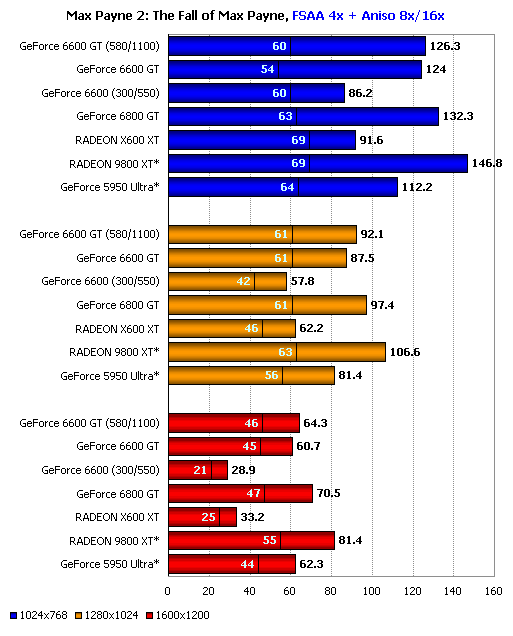
With full-screen anti-aliasing and anisotropic filtering enabled at the same time, the RADEON 9800 XT takes the lead even outperforming the GeForce 6800 GT.
Game tests: IL-2 Sturmovik: Aces
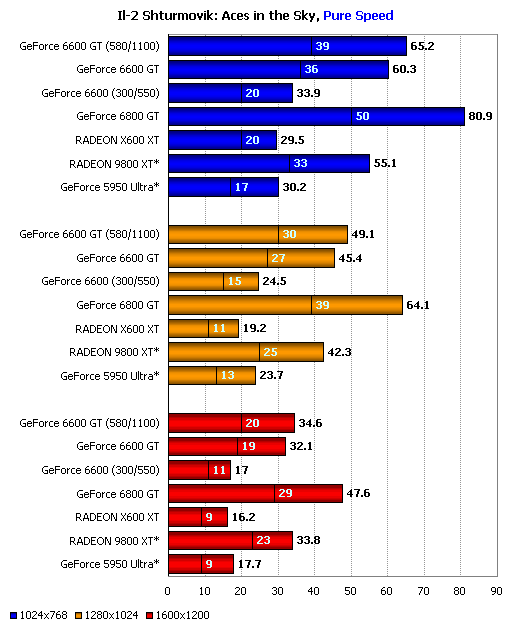
Due to the high core frequency, the NVIDIA GeForce 6600 GT outperforms the ATI RADEON 9800 XT, but as the resolution increases and the load on the video memory bus increases, the advantage of the GeForce 6600 GT fades away.
The youngest model, GeForce 6600, outperforms RADEON X600 XT, shows results at the level of NVIDIA GeForce FX 5950 Ultra.
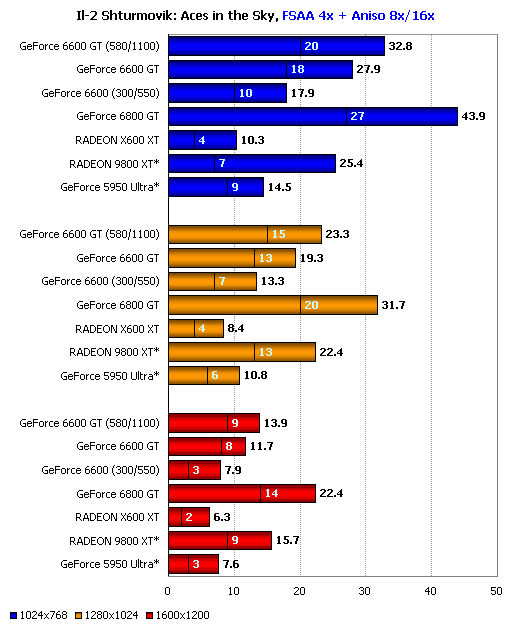
When you enable anti-aliasing and anisotropic filtering, what should have happened – the GeForce 6600 GT lacks memory bandwidth, and starting from the resolution of 1280×1024 it loses the leadership to the RADEON 9800 XT.
Game tests: Lock On: Modern Air Combat
Lock On, perhaps, cannot boast of such a luxurious picture as the latest version of the Il-2, however, the level of hardware requirements for this flight simulator is, perhaps, no less.
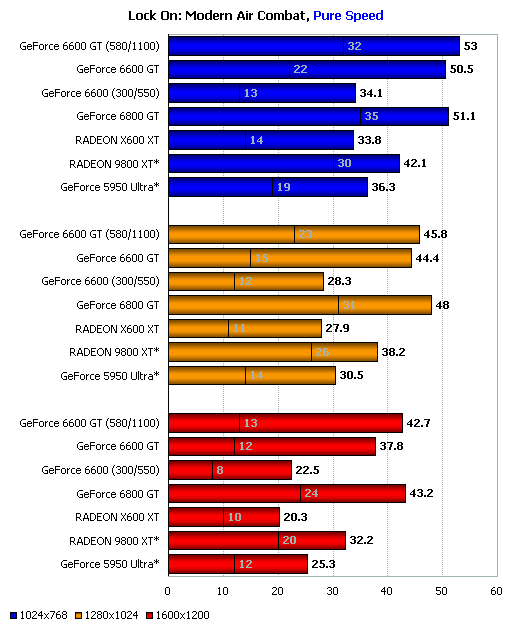
NVIDIA GeForce 6600 GT successfully competes not only with the cards of the previous generation, but even with the GeForce 6800 GT itself! The GeForce 6600 is again competing on equal terms with the RADEON X600 XT – it could have shown better results, but it is limited by the low frequencies of the GPU and video memory.
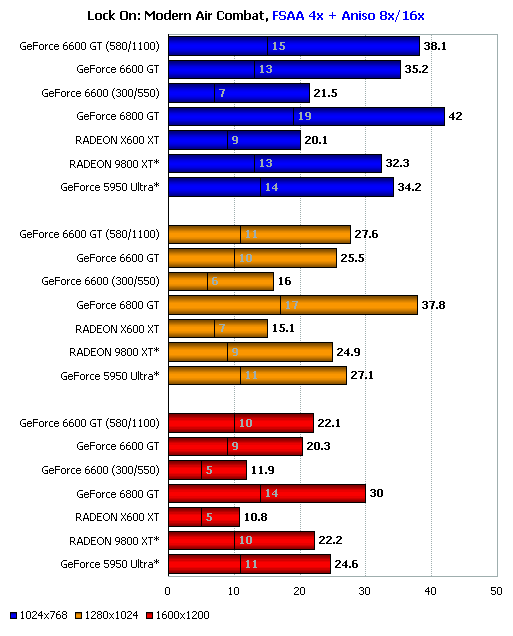
When full-screen anti-aliasing is enabled, the GeForce 6600 GT is almost on a par with the RADEON 9800 XT, despite the fact that the new product from NVIDIA has a twice narrower memory bus.
Game Tests: Colin McRae Rally 04
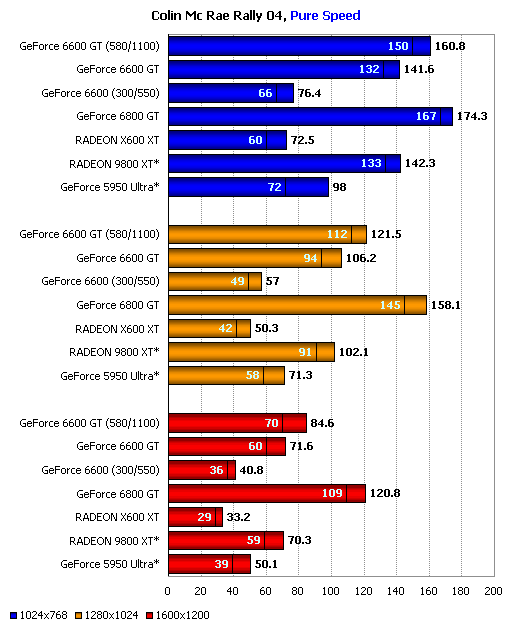
And again the GeForce 6600 GT proves that it is able to cope with last year’s leaders – the card easily outperforms the RADEON 9800 XT.
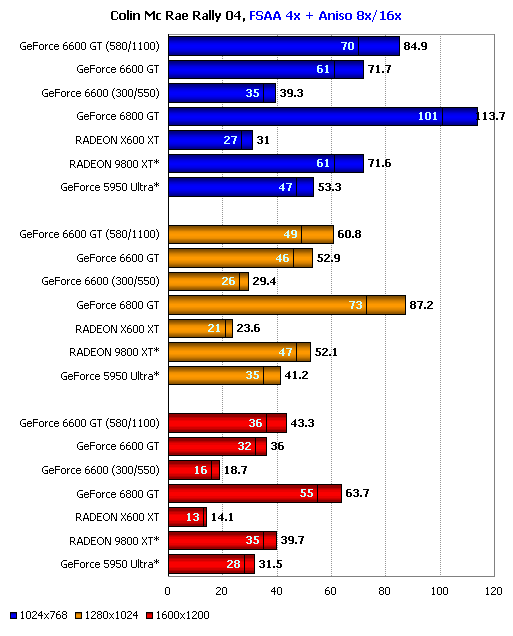
When anisotropic filtering is enabled simultaneously with full-screen anti-aliasing in 1600×1200 mode, the novelty is clearly limited by the relatively low speed of the memory subsystem.
Game tests: Command & Conquer Generals: Zero Hour
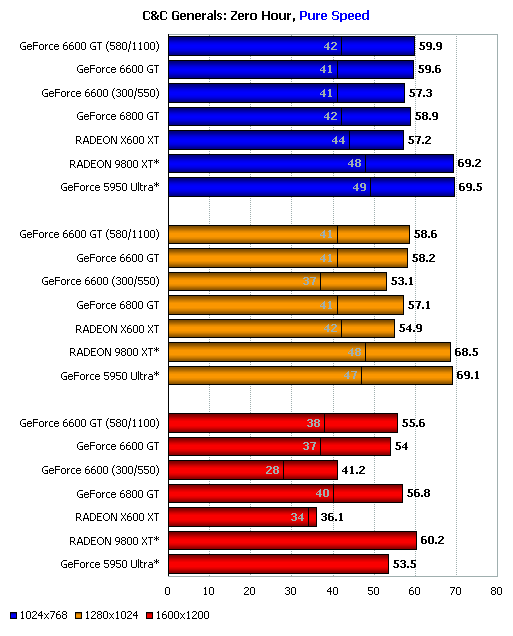
In this game, more or less adequate results can be observed only at 1600×1200 – at lower resolutions the results are clearly limited by the speed of the central processor.
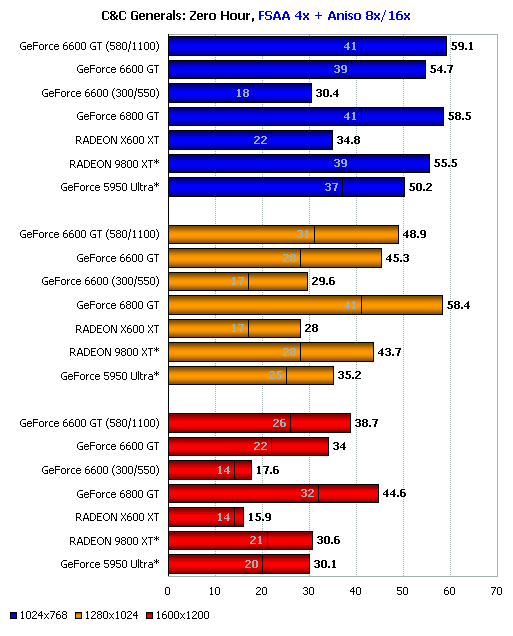
Anti-aliasing and anisotropic filtering increases the load on video cards, and the picture becomes more definite: the GeForce 6600 GT shows slightly higher results compared to the RADEON 9800 XT.
Game Tests: Perimeter
3D real-time strategy Perimeter is perhaps the most demanding game in our review: even the fastest video cards perform poorly here.
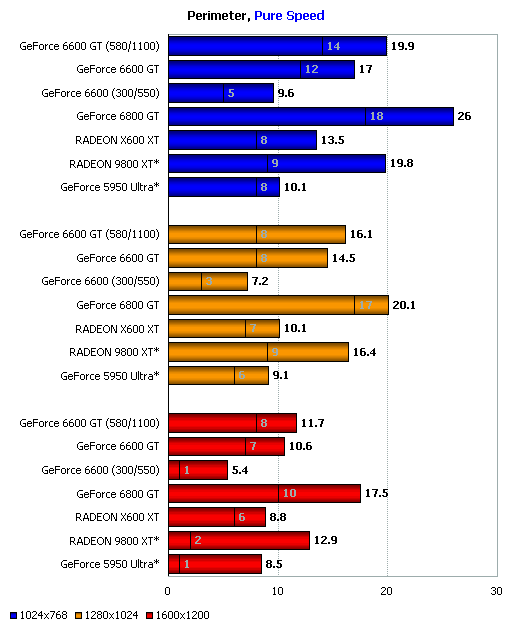
Thus, commenting in this game is possible only in the 1024×768 mode. If we talk about representatives of the middle class, the winner here is the RADEON 9800 XT, however, the second place is still taken by the GeForce 6600 GT, and the overclocking allows it to be on a par with the leader. The game gives preference to the architecture developed by ATI Technologies laboratories – this explains the victory of the RADEON X600 XT over the GeForce 6600.
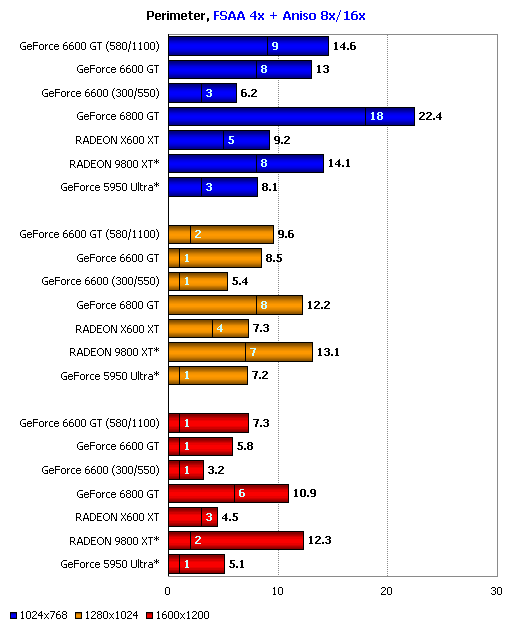
Almost the same is observed here as in the case of the pure performance mode, however, none of the cards provides acceptable playability.
Conclusion:
So, in real conditions, the new family of mid-range video cards from NVIDIA proved to be excellent. Briefly summarizing the results of gaming tests, we can say with confidence: NVIDIA GeForce 6600 GT today not only outperforms the RADEON 9800 XT in speed, but also offers a wider set of functions.
Victory over the former performance benchmark, the ATI RADEON 9800 XT video adapter, in most of the tests is an excellent result for a relatively simple card equipped with a twice narrower memory bus. High clock speeds and more perfect architecture of the new generation have done their job: RADEON 9800 XT, yesterday’s leader, is defeated by the mid-range solution in today’s games such as Doom III, Unreal Tournament 2004, FarCry, Counter Strike: Source.
The novelty has shown excellent speed in modern games rich in complex geometry and widely use pixel shaders – in these games the frequency and efficiency of the GPU affects the result more than the speed of the memory subsystem.
When full-screen anti-aliasing and anisotropic filtering are enabled, the comparatively low speed of the memory subsystem, of course, begins to limit the results of NVIDIA GeForce 6600 GT, but even in such modes the new product generally shows results at the level of ATI RADEON 9800 XT.
The younger model, NVIDIA GeForce 6600, outperforms ATI RADEON X600XT in most tests, and this is not surprising – despite the fact that the GeForce 6600 graphics processor operates at a much lower frequency, it has eight pixel pipelines – twice as many as in the RADEON X600 XT. At the same time, do not forget that the GeForce 6600 has an indisputable advantage over the RADEON X600 XT in terms of functionality – at least support for shaders 3.0.
The NVIDIA GeForce 6600 family is, without exaggeration, a leading edge in its class. Before their appearance, their “target” market niche was practically empty: various variations on the theme “GeForce FX + HSI bridge” could not boast of high performance, and the RADEON X300 and X600 were nothing more than the reincarnation of the RADEON 9550 / 9600XT, which also cannot boast a really high speed – the speed on the level of ATI RADEON 9800 XT and NVIDIA GeForce FX 5950 Ultra.
Unfortunately, the GeForce 6600 GT and GeForce 6600 exist only in versions for the PCI Express bus. The release of AGP-versions of boards in the future is quite possible, since the AGP-PCI Express bridge used by NVIDIA in its other products can work in both directions, and nothing prevents them from equipping a card with an “innate” PCI Express interface, making it work on the bus AGP. The demand for this version of the GeForce 6600 GT should be very high, so the likelihood of the appearance of AGP versions of the GeForce 6600 GT and GeForce 6600 in the near future is almost beyond doubt.
Speaking about the availability of new video cards based on GPUs from NVIDIA, it should be noted that, unlike the GeForce 6800 family, whose representatives are still in short supply, there should be no special problems with the GeForce 6600/6600 GT: firstly, these GPUs are much less sophisticated than the GeForce 6800 series chips, and second, they are manufactured at TSMC, not IBM. Thus, delays and shortages are not to be expected. So, the first move has been made, but the final word in this season’s struggle has not yet been said. Following NVIDIA and its breakthrough with the GeForce 6600/6600 GT, undoubtedly, ATI will also make its move – the RADEON X700 series of graphics processors is already awaiting an upcoming announcement.





